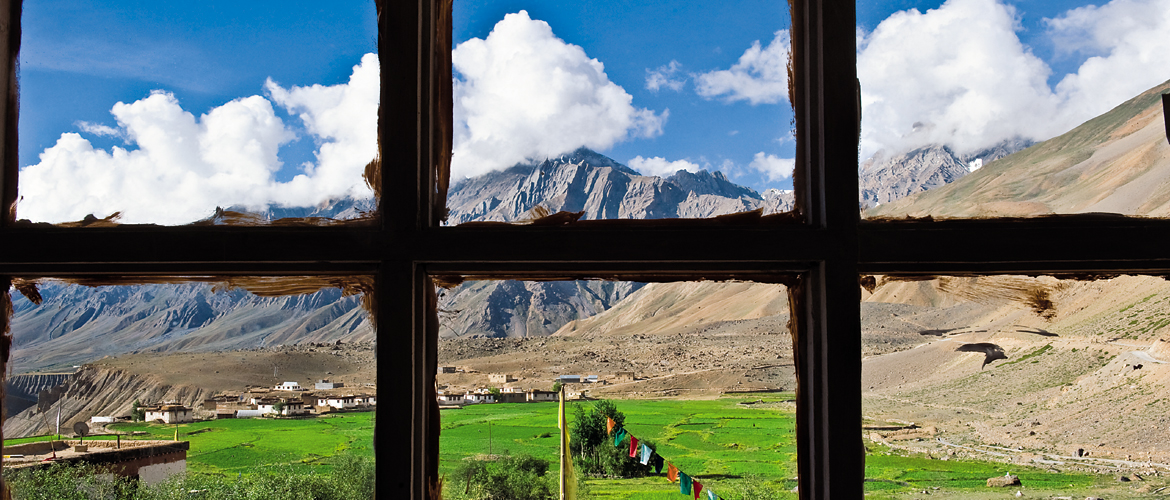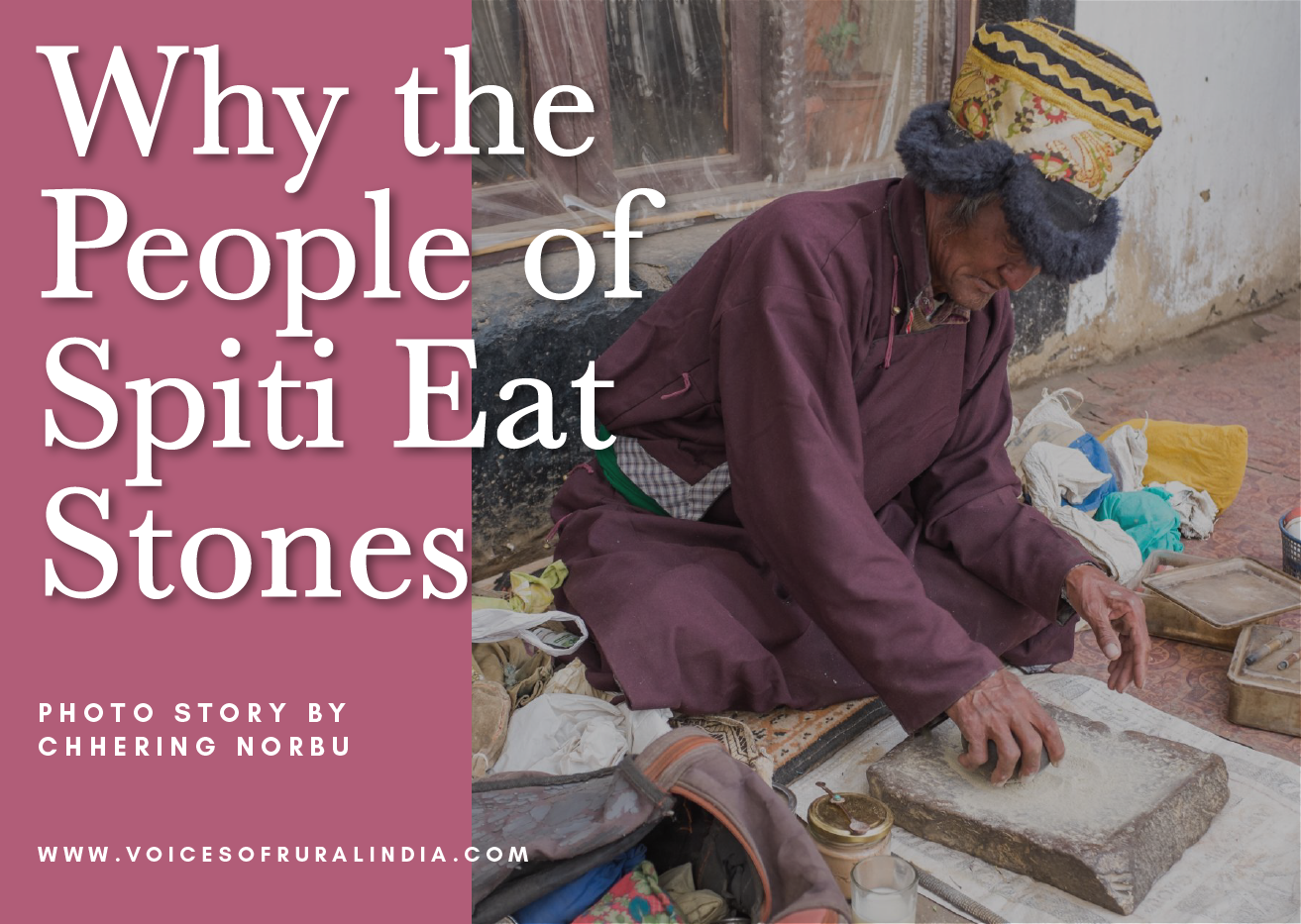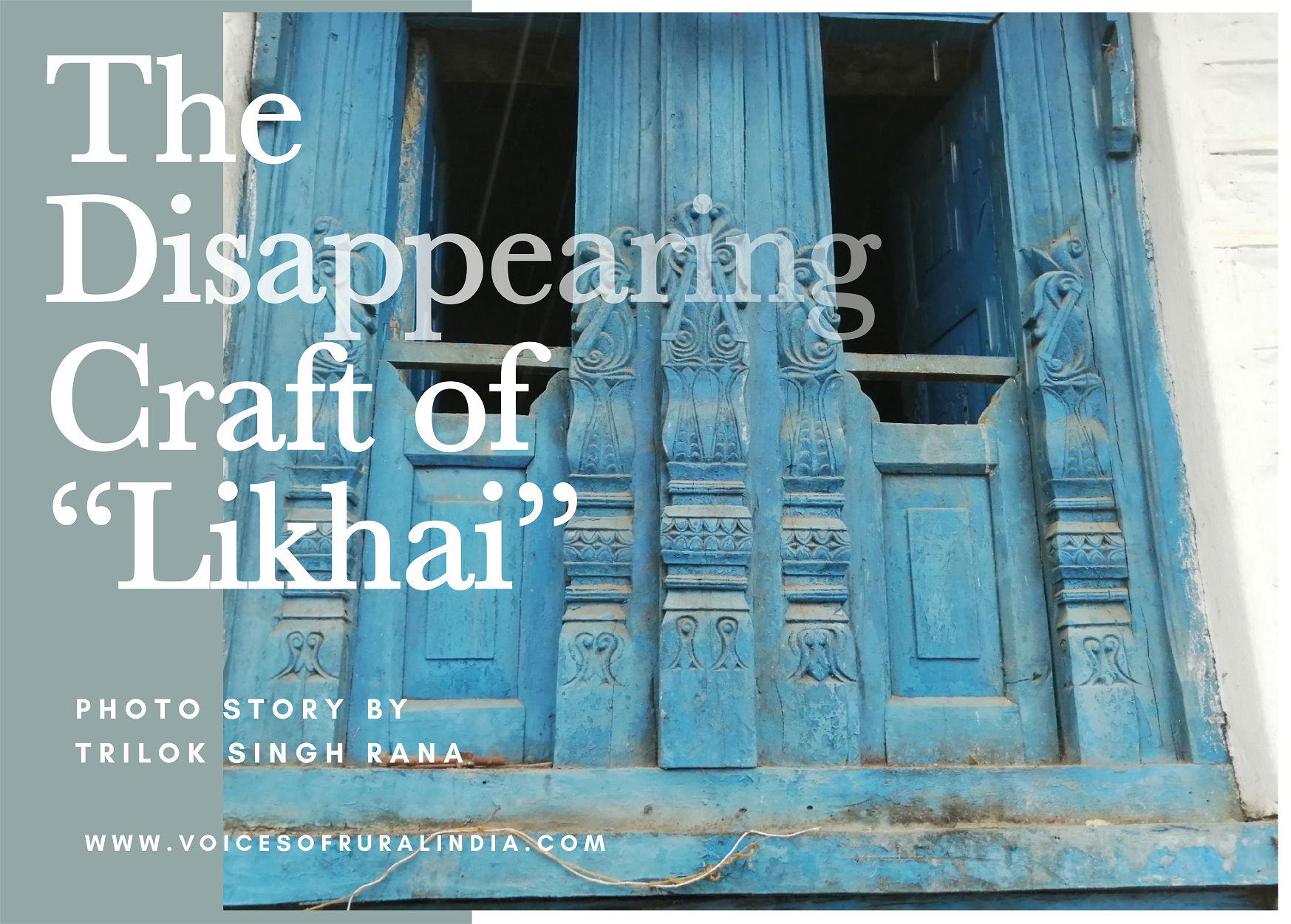
Ecosphere, an organization in Spiti, is offering an immersive taste of local life
I’m still recovering from an exquisite panoramic view of the Trans-Himalayas from atop a cliff 5,000m above sea level, when Kunga brings me something cupped carefully in both hands, his excitement redolent of a child flaunting his favourite figurine. It’s a plant. Well, parts of one. He peels the skin off a stem and hands it to me. “It’s called rubaab [sic]. It’s perfectly edible,” he assures me. The light-green stem is sour, with hints of a sweet note, its texture on the tongue similar to sugarcane’s, and size that of a straw. “When we go into the woods to graze cattle, this is our lunch; it has vitamin C and E. They even make jam from it in Europe,” states Kunga, as he merrily munches away at a bunch of rhubarb stems on our trek down from Balari top to Demul village.

Further ahead on the trail, Kunga points out a shrub with tiny red flowers, which when combined with some roots, make for an excellent analgesic. We pluck purple cloves of wild garlic as aid for high-altitude breathlessness, and for culinary use. We’re in Himachal’s Spiti valley and this is no regular sightseeing tour. Kunga Lodhren is a 24-year-old guide and cook with Ecosphere, an organisation which works with locals to facilitate responsible, eco-friendly tourism. We’re here to get a taste of the Spitian way of life while treading a breathtaking mountainscape over three days by engaging in activities designed to this very end.

On our first day, we find ourselves in the kitchen of Sol Café, a cosy eatery run by Ecosphere amidst the din of the only market in Kaza, the sub-divisional headquarters of Spiti where we’re based. For someone as dyslexic in the culinary realm as I, cooking a local dish is no mean feat. Kunga has his task cut out, which becomes obvious as I start chopping onions, tomatoes, carrots, potatoes and cauliflower to make the gravy for keu, a local version of pasta. Next up is fashioning dough out of super-refined wheat flour. The dough is then flattened and tiny dumplings of it dropped into the boiling mix of veggies and spices in the cooker. The dish that is served after 10 minutes is surprisingly scrumptious.

Now that we’ve made the food, we must do the dishes. It is no coincidence that we head to Langza to throw a pot. The village gets its very name from the craft. ‘Lang’ stands for temple and ‘za’ denotes a certain kind of mud found here which lends itself to pottery. Until around half a century ago, the annual Ladarcha festival saw traders from Spiti and Ladakh barter items of business here, including a certain chemical (locals call it namak) which reinforced the pots and prevented cracking at high temperatures. But, over the years, as plastic and metal invaded lives, the mud pot lost its place on the kitchen shelf. And the namak disappeared. Today, a lone potter is active in the village that was named after its clay. Fifty-six-yearold Dorje Angchuk now uses the potter’s wheel to make artefacts like candle holders, flower pots and even replicas of sea fossils which are routinely found in the area.

The first step of the process is surprisingly similar to cooking. I’m trained in making dough out of the moist mud. It’s beaten into a firm ball to remove air bubbles and placed on the potter’s wheel, which is driven by foot. Over the next hour, my sloppy hands learn the fine nuances of pot making–from centering the dough to carving out the perfect cavity and tapering the rim. The final product bears the marks of a newbie but isn’t too bad. This pot will now travel to Kaza to bake in an oven at 800- 900°C before acquiring a glaze.
While it’s best known for its mud, Langza is blessed with a singular location at an altitude of 4,400m. The snow-clad peak of Cho Cho Khangilda stands tall at 6,303m, keeping watch over the nondescript village which has just 33 houses. In 2005, an enormous golden Buddha statue was erected at the highest point of the village. The medicine Buddha stands pensively, gazing at the Trans-Himalayan range, holding a bowl of herbs. As many as 340 medicinal plants grow in the valley and the belief in nature is deep-rooted.
Out here, it’s normal for a villager to first consult a local medic (amchi) trained by his ancestors in the use of herbs or the village deity (which manifests itself in a chosen person called la) before resorting to Western medicine. At one point in the tour, we witness a chowa (local tantrik) bless alcohol bottles from every household of a village to give them medicinal properties.
While the deities seem to have a stranglehold on the valley, locals often find themselves torn between two belief systems. Their religion, Tibetan Buddhism, decries these deities as hungry ghosts. When I ask Nima, another cook and guide, about this dilemma, he says they invoke their deities only in an ‘emergency’. But the deities of the valley are far less regressive than in other regions of Himachal, says Ishita Khanna, founder of Ecosphere. In fact, these days they render advice in alignment with an organic lifestyle and ecological conservation, adds Khanna. For instance, every village here brews its own alcohol with locally produced barley. At some point, they began using a chemical to expedite the fermentation. One of the deities manifested in the village la and asked them not to continue the practice as the chemical was unhealthy. It also asked them to graze their cattle over a wider area so as not to deplete the resources of a single hillock
Lahaul-Spiti was once two separate districts. While Lahaul has a mix of Hindus and Buddhists, all the residents of Spiti follow Tibetan Buddhism. To better understand their religion, we spend the second day with Buddhist nuns at Pangmo, one-and-a-half hour away from Kaza. The nunnery here started in the 70s with 12 nuns meditating in a cave for 7-8 years. Today, it’s a concrete, two-storeyed structure that houses 46 nuns, the youngest of them just four years old. Discipline is central to their lives. Each session of the day commences with the tolling of a brass bell. Their studies begin at 5.30am, when a guru, the only monk in the nunnery, teaches them Buddhist scriptures. There are sessions in Tibetan, English, Hindi and Math during the day, interspersed with praying time.

But the session that stands out is called ‘debate’. At 9am, the nuns are paired up according to their age. In each pair, one sits on the ground and answers questions posed by the other, who makes a resounding clap at the end of every query. A cry of ‘So che!’ (Answer quickly!) mocks the sitting nun for not knowing an answer. The questions come from their holy books, mostly from lessons learnt earlier that morning. It’s a revision test like no other. Later, the exercise is repeated in groups, where it acquires a competitive tenor.

In the afternoon, the little nuns turn teachers, helping us navigate the Tibetan alphabet. I learn how to write my name in a script where every letter looks the same, and the proper way of chanting Buddhist hymns, including ‘Om Mani Padme Hum’ and ‘Om Tare Tuttare Ture Soha’.
The nuns’ hospitality is typical of Spiti. Locals help each other in everything, from building homes to everyday commute. There are few means of public transport, if any, in this hilly terrain. Hitchhiking is a way of life. So, when it’s time for us to go–after we’ve been fed two wholesome meals and a gazillion cups of tea–the nuns hail a truck passing by, and bid us a reluctant farewell.

The third day could very well be called Yak Day. We head to Demul village (4,310m) to get a lesson in twining rope out of yak fur. Yaks are the most common domesticated animals here, besides cows. The fur on their back, called khulu in Bhoti, is soft, warm and plucked at the onset of summer, to make sweaters and blankets for winter. The fur on their belly, sitpa, is much tougher and clipped off to make ropes. The haircut, in turn, helps the yaks cope with summer.
A mass of sitpa is first ground between two phalsets, huge combs with iron bristles, to soften and untangle it. The resulting strands are stretched and wound around a wooden stick. This is then doubled over and intertwined a number of times, end to end, until the strand becomes a thick rope strong enough to strap a man to a saddle.
My teacher, 41-year-old Angdui Phunchok, is a simple man who wears a permanent smile. Even when his two kids tear his house down or when I ask him to repeat the same step a third time. He says twining is a pastime for locals in the harsh winters of Spiti, when temperatures dip below -30°C and even the cattle is given shelter inside dens built into the house structure. His modest mud house has a single large room that serves as dining space, bedroom and kitchen for the family of five. Mattresses and low tables are lined up along three walls facing an old-fashioned idiot box and a cupboard full of crockery. I count at least 35 cups, polished to perfection. “We get a lot of visitors,” he explains. In fact, every kid of the valley gets one huge birthday bash in their lifetime, at 2 or 3 years of age, where all Spitians congregate. While he explains this bond among villagers, Angdui armed with an astonishing muscle memory finishes the rope, stitching together the last two thick strands, with a thread made of, yes, yak fur.

Puneet and I mount two yaks, aged 11 and 13–both called dullu for a lack of horns, to reach the the cliff-face of Balari top. A yak is mighty enough to carry a human on steep slopes through the wild countryside but it has the heart of a mouse, startled by loud noises and strangers. The journey to Balari top is a trek to a vantage point for tourists, but for the people of Demul it’s a ritual. Kunga tells us the story as he treks alongside our yaks without breaking a sweat.
Every year, after a three-day harvest of wild grass in August, locals of Demul celebrate the ‘Namkan’ festival. The head of every household sports a traditional costume and races the others on horseback to Balari top. The winner gets ₹1,500 and any head not participating is fined ₹500. This piece of historic information gives our journey uphill a different meaning altogether.
A friend once asked me to listen to the mountains, “for they speak,” she said. I’ve always been an ocean person so I didn’t pay much heed then. But, as I stand atop Balari, I hear the mountains whisper a singular cosmic hymn, riding the feathered back of the mighty wind. Below, the Spiti river flows relentlessly; on the horizon, the Trans-Himalayas wear a veil of clouds, furtively feeding snaking streams with their glaciers. Spiti has taught me one simple lesson: If you’re not in love with the mountains, you haven’t climbed the right one yet.
The Information
Getting There
The only way to get to Spiti is by road. The road from Manali has two passes–Rohtang Pass and Kunzum La–and is open from around mid-June to mid-October, depending on the weather. This is also the best time to visit Lahaul and Spiti, as the mercury can dip below -30°C in winter.
A single bus leaves from Manali at 6am every day (₹400). But the best way to get there is on a shared jeep (Tata Sumo). Many of these make the journey every day and a seat costs ₹1,200 (varies according to demand).
The average time of the journey is 11-12 hours. You could also drive yourself up but bear in mind that the route is treacherous, with mountain streams flooding the ledge-like road at many places. Smaller vehicles tend to get stuck. Chandratal, a popular tourist destination, doesn’t fall on the shortest route. Hence a private jeep has to be booked to take a 13-km detour. It can set you back by ₹8,000-10,000.
An alternative route from Shimla to Spiti is open nearly throughout the year but takes much longer. One can also trek from Manali through Hamta Pass to reach Spiti.
Where to Stay
We stayed at Ecosphere’s guesthouse, Osel Rooms, which offers seven rooms in Kaza (₹800-1,000; 9418860099, spitiecosphere.com).
Alternatively, there’s Sakya Abode and Hotel Kunphen, each with 12 rooms (₹1,100-1,540; 9418208987, sakyaabode.com).
There are now some 40-50 guesthouses and homestays in this town, a major upgrade from just the one 15 years ago. Other villages in the valley have only homestays that charge anything between ₹700 and ₹1,500 per night. The food offered is made to order by locals.
What to Eat & Drink
A wild berry called seabuckthorn grows along the river bank. Nicknamed the Miracle Berry, it is supposed to be the only plant with all the Omegas–3, 6, 9 and 7. These plants are also a rich source of vitamins, minerals and antioxidants, and are available in the form of crush, tea and jam in the cafés at Kaza. The breads, tirik and tingmo, are both made with wheat flour. A traditional Spitian thali is my idea of a wholesome meal. Locals swear by their butter tea, but I wouldn’t have it again even if you paid me to.
What to See & Do
You can base yourself in Kaza and take up day-long activities like we did. Ecosphere offers activities immersed in local traditions like ‘Nun for a Day’ (₹1,000), ‘Cook like a Local’ (₹500), ‘Throw your Own Pot’ (₹500), and ‘Yak Rope Twining’ (₹500). You could also rent mountain bikes and explore the grand monasteries in Ki, Tabo or Dhankar. I highly recommend a yak safari from Demul to Balari top (₹1,500). For a 7-8 day tour, you can also trek through villages in Spiti, staying at homestays in each village overnight.






